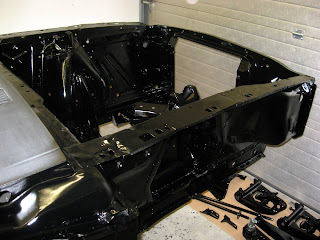The parts for front suspension had been media blasted and primered in spring. I painted them black along with the engine compartment. The lower control arms got updated with new bushings but the ball joints appeared to be in such a good condition that I approved them. As a matter of fact if they are worn, you need to replace the LCAs as a whole. If both your upper and lower control arms are in a bad shape you might consider a kit available from Cal Mustang for replacing all the control arms. But I did not want to invest to them at this time. These will do until I'll do the disc brake conversion as well. 
First I attached the LCAs and the sway bar with new end links. I had ground the rivets off the original upper control arm ball joints. The new ball joints seem to have the grease fitting in a diffent place than what the originals did. Therefore the screws were installed sort of upside down. Maybe it does not matter anyhow. The camber and caster are adjusted with shims in '65s. I installed them back as they were when disassemled. The control arms are similar on both sides so there is a fifty-fifty chance that I've mixed them. I'll have to adjust the camber and caster later anyhow.

Next: I attached the strut rods. These are the old ones which have only been blasted and painted. Even the rubber bushings at the front end of the rods are original.

I could not figure the purpose of the "wings" between the strut rod and the LCA even though I studied the Mustang Illustrations Catalog. But I decided to install them back anyhow.
Later I discovered that the wings act as limiters for steering. If turn enough the spindle arm will meet the "wing" and prevent the wheel from turning too much.
Once the control arms were ready I placed the spindles in between. And not only the spindles but the RUSTY (???!!!???) front brake drums also. OK, I'll do something for the drums at the time when all the for drum brakes are checked. The back side of the drum brake plate was cleaned with wire brush and painted black.
I want this vehicle to roll so I won't spend time with rusty brakes for now.
The front coil spring got themselves new insulators for upper ends and a coat of enamel. Here is shown a best position for compression tools (borrowed from a friend, thanks). I decided that there must be six rounds of coil spring wire between the jaws. Take some time to position the jaws in a way that they will not be in way when you place the spring between UCA and the shock tower top end.
And here is the coil spring 4 inches shortened and ready to go in. Instead of ratchet you may find useful to use wrench tool for loosening the compressor tool because...

...you may end up with a situation where you can not detach your ratchet because there is no more space left. I know , I did and had to compress again.

But finally the spring was there.

My carage is small, only 6,0m x 3,5m. Therefore I need to move my car while proceeding with the project. This can be done with a help from a couple of friends and their wives or by rolling the car on its own wheels with a help from my own wife. That's why the steering box and linkage are the next thing to be installed. Not much time did I spend with restoring the steering box. You can not fix it art home. If it's worn replace it. The steering shaft is Spear O'matic -type, a solid rod which may be harmful for your chest in case of an accident.

And the opposite side companion for the steering box: the pitman arm.
Tie rods were worn to an extent that they were replaced with new ones. I'm so stingy that I revived the original tie rod sleeves and installed the tie rods prior to attaching them. I screwed an equal amount of threads at both ends so while adjusting the toe neither of the tie rods will drop out of threads. And a rule of thumb is that the tie rod with counter-clockwise threads is the outer one. The inner ones have normal, clockwise threads.
I couldn't resist the desire to see Destiny ( I call her My Destiny nowadays) on her front feet shamelessly posing with the new KYB Gas-a-Just shock absorbers. I would have preferred the softer and cheaper GR2-type of KYBs which might have been better for a daily cruiser but my local dealer bargained these for 100 € /pair VAT 18% included. ($150) . In US you can obtain ones from NPD for $43,95 /each.

A lot of negative camber seen in this picture below. This is the weakness in Mustang's front suspension. The camber variates depending on the ride hight which is not good for the grip. Too much negative in the up-position and too much positive in down-position. Those willing to improve their vehicle's handling and performance on curvy roads may want to do something for this disadvantage. But I don't ! At least not
anymore. No reason for adjusting camber/caster/toe at this point. The front will move downwards once the 200/C4 is installed.























































